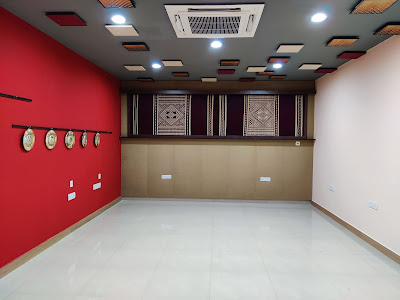Pattamadai Mats: An underappreciated art of finesse at the verge of extinction
Pattamadai Mats are exquisite hand woven mats made
up of Korai grass that grows along the banks of the river Thamirabarani,
Tamilnadu. As mentioned in various
Tamil folk songs, gifting Pattamadai mats to the newly wedded couples was a
celebrated tradition. The mats can be customised with the names or even
portraits of the bride and groom. The mat comes in various patterns, degree of
fineness and rich colour schemes.
Background
The silk mats are the
most colourful and the finest creation of Pattamadai and were even exported to
other countries in the past. Based on the number of strands accommodated in one
inch, the mats are classified into 32 counts, 50 counts, 100 counts(silk mats).
120 and 140 counts are no longer made. The korai grass is also cultivated in
other places as Karur, Manimutharu, Karambai, Ulupadipaarai,
Karisoolthamangalam and Kallidaikurichi. It grows along the river bank and has
high strength and is even believed to have medicinal values.
The journey
We
visited Mrs.Haiwa Beevi, a master weaver at Pattamadai to know about the
weaving process, to evaluate the work environment and to understand the setbacks
involved. The process starts from harvesting and splitting the korai grass, dyeing,
setting the floor loom, weaving and finally compressing the mats. The women
working on the floor looms had almost come to state of acceptance about the
back pain caused due to improper furniture setup. It takes a month to complete
one or two mats resulting in a daily wage as low as Rs.50-100.
Even
with these huge drawbacks, Mrs.Haiwa beevi, the self-made woman said proudly, “every work has its own disadvantages and
nothing comes easy. Weaving the mats has empowered me to be independent and gives
me immense job satisfaction”. Her positive attitude and perseverance pushed
our team to come up with various interventions.
Technological Assistance
Under
the guidance of Er.Vinoth, our team is designing simple tools and machines that
can ease the labour strenuous process of Vaguthal(splitting
of korai) and Kadathuthal(compressing
of mats). A separate research is being conducted by the biotech department to
analyse and increase the availability of the raw material-korai grass (Cyperus pangorei). Analysis of natural
colour dyes in the mat, instead of chemical dyes is also under progress.
Exploration in Acoustics
Advocating a material to the construction industry requires evident based analysis. We organised an acoustical workshop and conducted various tests analysing the Noise Reduction Coefficient, Absorption coefficient and construction details of the Pattamadai mat.
The performance of a conference hall was analysed before and after acoustical treatment and the results showed that the mat when combined with foam displayed good sound absorptive and diffusive characteristics.
Ergonomic analysis
By understanding the
ergonomics and documenting the floor loom of the Pattamadai weavers the seating
for the floor loom was redesigned. Our team came up with a floor sitting furniture
design, to reduce the strain caused while weaving, especially helping the
majority of women weavers during the time of pregnancy and menstruation.
Design Interventions
Incorporating
the modern design suggestions with unique colour combinations, 11 new mats were
weaved and are now sold in the Kural online
boutique. Apart from the direct usage, these mats are incorporated in daily use
products like laptop bags, sling bags, paper files,etc.
Lastly,
a new start-up for weaving silk mats, ‘Banu
Pattu pai centre’, named after Mrs.Haiva Beevi’s daughter was established.
It has helped a group of 15 women and we aim to achieve more.
Giving
a voice to the unvoiced,Swastha IlangovanTeam Kural












Comments
Post a Comment